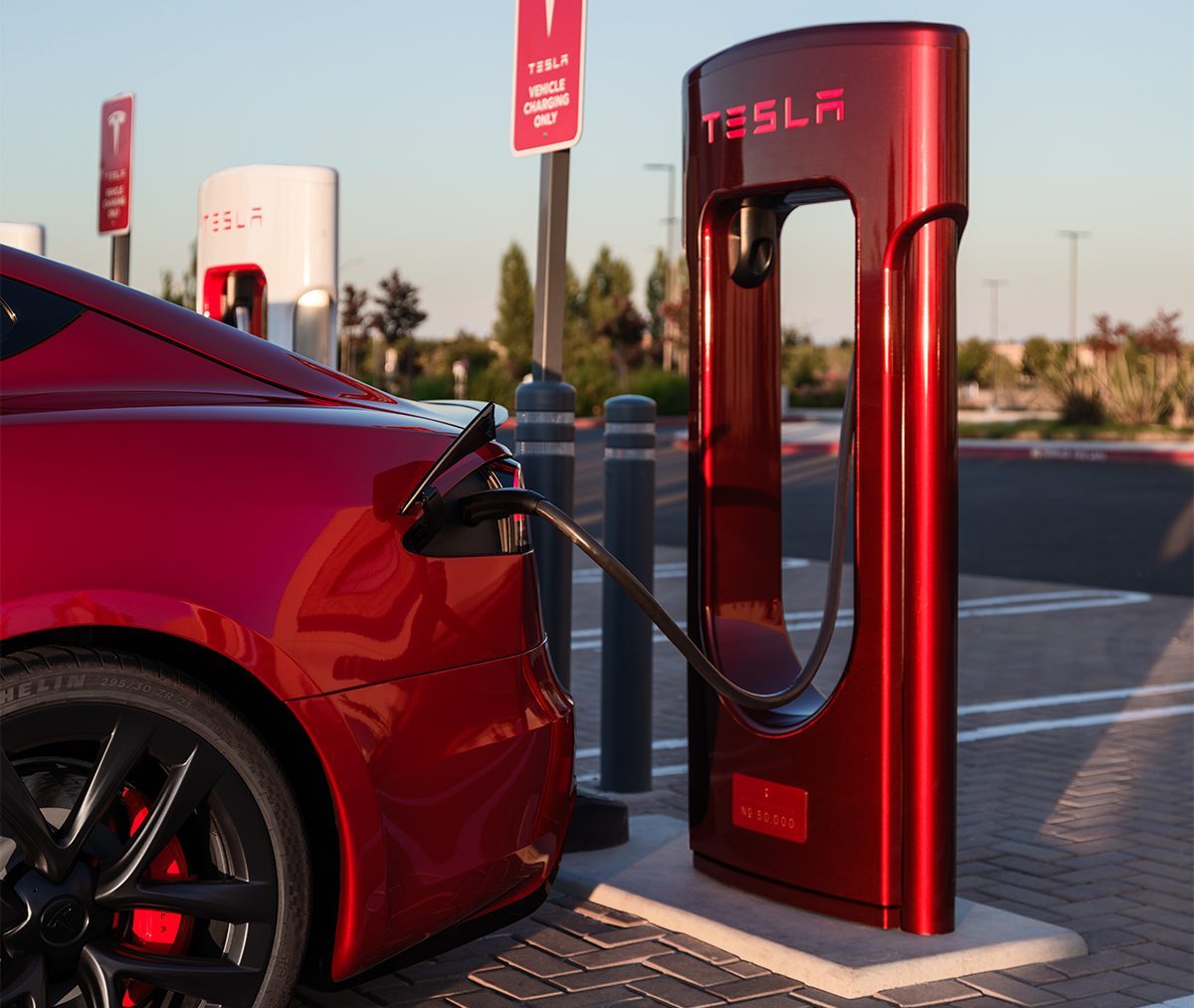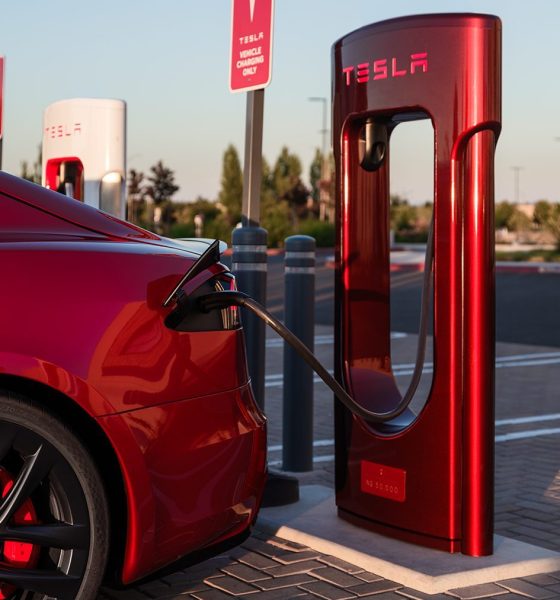Even if electric cars are already prevalent today, anti-EV narratives are still abounding. Among the most persistent anti-electric vehicle talking points involves the idea that EVs take hours to charge, so those who own them would be stuck waiting several hours waiting for their cars to “fill up.” A recent post from Tesla’s official social media handle debunks these ideas.
Longtime Tesla and electric vehicle owners have noted over the years that EV charging practices are far different from refueling a combustion-powered car. As the electric vehicle maker posted on its official handle on X, the social media platform formerly known as Twitter, charging a Tesla is actually far simpler than expected.
When charging at home through a Wall Connector or Mobile Connector, for example, all Tesla owners need to do is plug in their cars when they pull into their garage. EVs are like gigantic mobile devices, so just like smartphones, they could simply charge their batteries while their owners go about their day. And with the Wall Connector or Mobile Connector, Tesla owners can typically wake up to a fully charged car per day.
How to charge your Tesla
At home
1. Plug in in your garage using a Wall Connector or Mobile Connector
2. Wake up to a fully charged car the next day
→ https://t.co/vJ2oWGCWLk
On the road
1. Stop at one of 55k+ Superchargers globally—charging stops are automatically included…— Tesla (@Tesla) March 14, 2024
When using Superchargers during long trips, Tesla owners could simply stop at a Supercharger station — of which there are 55,000 globally today — and plug in their vehicle. Tesla’s vehicles are designed to include charging stops in their navigation, and they also preheat their battery to enable faster charging speeds.
Charging at Superchargers is very convenient, as drivers and their passengers can simply grab a bite or go for a bathroom break while their Tesla is Supercharging. The best thing about Superchargers is that drivers are notified when their cars are finished charging, and their payment is automatically processed through their Tesla account. For Teslas at Superchargers, there is no need for card payments or dedicated apps just to fast charge the vehicle.
Charging a Tesla in resorts or other destinations is similar to charging at home. Thanks to Tesla’s Destination Charging network, electric vehicles could recharge their batteries while their drivers are spending the night at a hotel, or shopping for items at a mall.
One thing that Tesla highlighted in its recent social media post is the fact that EV charging is a passive activity. At home or in places with Destination Charging, drivers could generally just go about their day with the assurance that their Teslas are gaining some range. And during Supercharging stops, the rapid charging capabilities of the Tesla Supercharger Network typically result in stops being just as long as a quick snack or bathroom break. Overall, the charging experience of Tesla owners when charging at home, at locations with Destination Chargers, and at Superchargers, actually seems to be better than the active process of pumping gas at a gas station whenever a combustion-powered car needs more fuel.
Don’t hesitate to contact us with news tips. Just send a message to simon@teslarati.com to give us a heads up.

News
Elon Musk’s Grokipedia surges to 5.6M articles, almost 79% of English Wikipedia
The explosive growth marks a major milestone for the AI-powered online encyclopedia, which was launched by Elon Musk’s xAI just months ago.

Elon Musk’s Grokipedia has grown to an impressive 5,615,201 articles as of today, closing in on 79% of the English Wikipedia’s current total of 7,119,376 articles.
The explosive growth marks a major milestone for the AI-powered online encyclopedia, which was launched by Elon Musk’s xAI just months ago. Needless to say, it would only be a matter of time before Grokipedia exceeds English Wikipedia in sheer volume.
Grokipedia’s rapid growth
xAI’s vision for Grokipedia emphasizes neutrality, while Grok’s reasoning capabilities allow for fast drafting and fact-checking. When Elon Musk announced the initiative in late September 2025, he noted that Grokipedia would be an improvement to Wikipedia because it would be designed to avoid bias.
At the time, Musk noted that Grokipedia “is a necessary step towards the xAI goal of understanding the Universe.”
Grokipedia was launched in late October, and while xAI was careful to list it only as Version 0.1 at the time, the online encyclopedia immediately earned praise. Wikipedia co-founder Larry Sanger highlighted the project’s innovative approach, noting how it leverages AI to fill knowledge gaps and enable rapid updates. Netizens also observed how Grokipedia tends to present articles in a more objective manner compared to Wikipedia, which is edited by humans.
Elon Musk’s ambitious plans
With 5,615,201 total articles, Grokipedia has now grown to almost 79% of English Wikipedia’s article base. This is incredibly quick, though Grokipedia remains text-only for now. xAI, for its part, has now updated the online encyclopedia’s iteration to v0.2.
Elon Musk has shared bold ideas for Grokipedia, including sending a record of the entire knowledge base to space as part of xAI’s mission to preserve and expand human understanding. At some point, Musk stated that Grokipedia will be renamed to Encyclopedia Galactica, and it will be sent to the cosmos.
“When Grokipedia is good enough (long way to go), we will change the name to Encyclopedia Galactica. It will be an open source distillation of all knowledge, including audio, images and video. Join xAI to help build the sci-fi version of the Library of Alexandria!” Musk wrote, adding in a later post that “Copies will be etched in stone and sent to the Moon, Mars and beyond. This time, it will not be lost.”
News
Tesla Model 3 becomes Netherlands’ best-selling used EV in 2025
More than one in ten second-hand electric cars sold in the country last year was a Tesla Model 3.

The Tesla Model 3 became the most popular used electric car in the Netherlands in 2025, cementing its dominance well beyond the country’s new-car market.
After years at the top of Dutch EV sales charts, the Model 3 now leads the country’s second-hand EV market by a wide margin, as record used-car purchases pushed electric vehicles further into the mainstream.
Model 3 takes a commanding lead
The Netherlands recorded more than 2.1 million used car sales last year, the highest level on record. Of those, roughly 4.8%, or about 102,000 vehicles, were electric. Within that growing segment, the Tesla Model 3 stood far ahead of its competitors.
In 2025 alone, 11,338 used Model 3s changed hands, giving the car an 11.1% share of the country’s entire used EV market. That means more than one in ten second-hand electric cars sold in the country last year was a Tesla Model 3, Auto Week Netherlands reported. The scale of its lead is striking: the gap between the Model 3 and the second-place finisher, the Volkswagen ID3, is more than 6,700 vehicles.
Rivals trail as residual values shape rankings
The Volkswagen ID.3 ranked a distant second, with 4,595 used units sold and a 4.5% market share. Close behind was the Audi e-tron, which placed third with 4,236 registrations. As noted by Auto Week Netherlands, relatively low residual values likely boosted the e-tron’s appeal in the used market, despite its higher original price.
Other strong performers included the Kia Niro, the Tesla Model Y, and the Hyundai Kona, highlighting continued demand for compact and midsize electric vehicles with proven range and reliability. No other model, however, came close to matching the Model 3’s scale or market presence.
News
Tesla Model Y Standard Long Range RWD launches in Europe
The update was announced by Tesla Europe & Middle East in a post on its official social media account on X.

Tesla has expanded the Model Y lineup in Europe with the introduction of the Standard Long Range RWD variant, which offers an impressive 657 km of WLTP range.
The update was announced by Tesla Europe & Middle East in a post on its official social media account on X.
Model Y Standard Long Range RWD Details
Tesla Europe & Middle East highlighted some of the Model Y Standard Long Range RWD’s most notable specs, from its 657 km of WLTP range to its 2,118 liters of cargo volume. More importantly, Tesla also noted that the newly released variant only consumes 12.7 kWh per 100 km, making it the most efficient Model Y to date.
The Model Y Standard provides a lower entry point for consumers who wish to enter the Tesla ecosystem at the lowest possible price. While the Model 3 Standard is still more affordable, some consumers might prefer the Model Y Standard due to its larger size and crossover form factor. The fact that the Model Y Standard is equipped with Tesla’s AI4 computer also makes it ready for FSD’s eventual rollout to the region.
Top Gear’s Model Y Standard review
Top Gear‘s recent review of the Tesla Model Y Standard highlighted some of the vehicle’s most notable features, such as its impressive real-world range, stellar infotainment system, and spacious interior. As per the publication, the Model Y Standard still retains a lot of what makes Tesla’s vehicles well-rounded, even if it’s been equipped with a simplified interior.
Top Gear compared the Model Y Standard to its rivals in the same segment. “The introduction of the Standard trim brings the Model Y in line with the entry price of most of its closest competition. In fact, it’s actually cheaper than a Peugeot e-3008 and costs £5k less than an entry-level Audi Q4 e-tron. It also makes the Ford Mustang Mach-E look a little short with its higher entry price and worse range,” the publication wrote.










